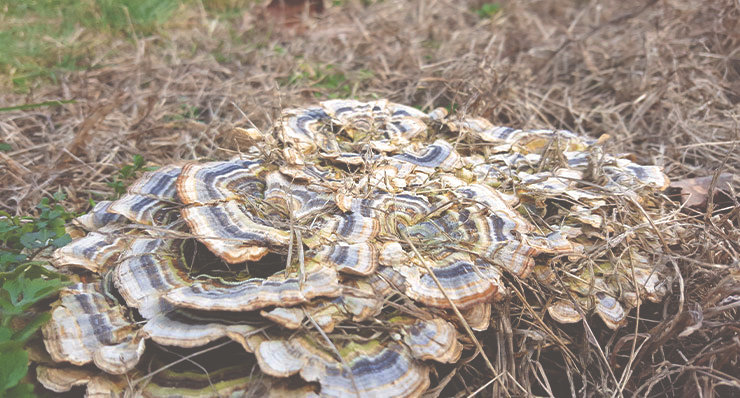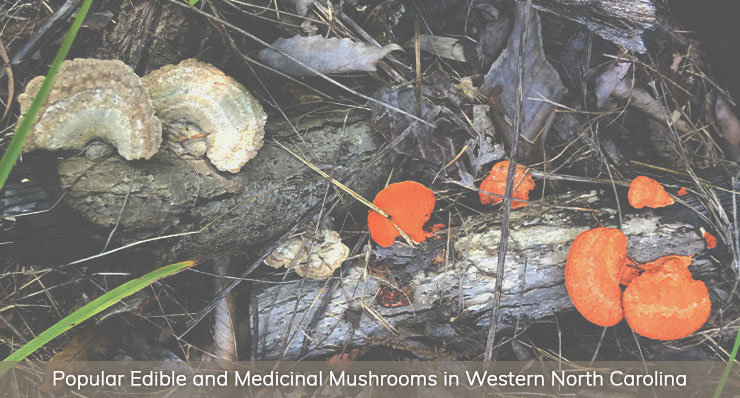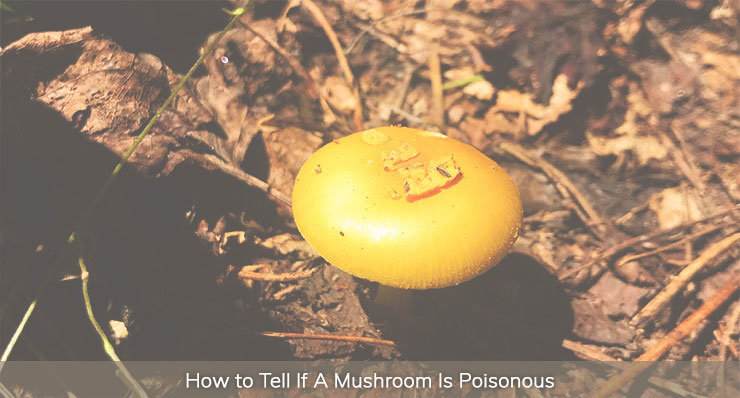
One of the many things that makes Western North Carolina so unique is its flora and fauna, especially our wide variety of mushrooms and fungi. Let us be your North Carolina wild mushroom guide, so you know what’s growing right in your backyard! Western North Carolina has a wide variety of mushrooms including medicinal, edible, and poisonous.
Throughout our North Carolina Wild Mushroom Guide, we mention many edible species local to Western North Carolina. However, while foraging wild mushrooms is very fun, we advise you to use extreme caution and do careful research before consuming any mushrooms that you may find in the wild. There are many species that have dangerous look-a-likes.
Popular Edible and Medicinal Mushrooms in Western North Carolina
Chicken of the Woods – This mushroom can be easily spotted in the woods due to its large size and clusters of bright yellow-orange colors. This edible species is sometimes considered a delicacy in certain parts of the world and is even said to taste like chicken. It is a great meat substitute for almost any dish. This particular mushroom is both saprotrophic and parasitic to trees and can always be found on the base of a living or dead tree.
Lion’s Mane – This fungus has no look-a-likes and all forms of it are edible. It is mainly found in the fall in the Southeast growing on lifeless hardwood tress. You can tell this species apart from others due to its tendency to grow a single clump of spines resembling a lion’s mane. Lion’s mane typically has a crab-like flavor and offers a range of health benefits such as reduced inflammation, improved cognitive, and heart health.
Maitake (Hen of the Woods) – This species of mushroom carries features that are both desirable for cooking and medicinal use. Maitake is found in late summer to fall and forms around the roots of dying or dead oak trees. It is intensely flavored and rather easy to cook. Maitake is also used medicinally to treat cholesterol, type 2 diabetes, and certain cancers. This species can be identified by its “leafiness” and brown tones with a lighter base.
Morels – Morels are some of the most highly desired ingredients among chefs and mushroom enthusiasts. This is due to their inability to be cultivated. These mushrooms are normally found in wooded areas in warm and wet conditions. They vary in appearance, but are all distinguished by their honeycomb exterior and their white and hollow interior. Beware when hunting for them as they have a deadly doppelgänger that’s more reddish brown to yellow. They also are not hollow inside.
Oyster – This species grows year-round in temperate forests and it produces a cluster of huge flushes on the sides of hardwood tress. It is probably one of the most versatile mushrooms, when it comes to temperature, as it can survive the hottest summers and coldest winters. The oyster mushroom is one of the most widely consumed mushrooms in the world and gets its name from its oyster-shaped cap. When cooked, they have a smooth texture and a hint of seafood flavor.
Reishi – Although this mushroom is technically edible, it has a bitter taste and is rather tough. Reishi can be identified by its large, dark and glossy exterior and wood-like texture. This species is mainly used for medicinal purposes and is often taken in liquid, capsule or powder form. Reishi is used to help enhance the immune system, reduce stress, improve sleep, and lessen fatigue.
Shaggy Mane – Shaggy Mane is one of the easiest species of fungi to identify. It has white caps and is considered a great choice for beginner foragers. There is only one similar species to shaggy mane, but if it is mistaken, there is no need to worry because it is edible, too! A distinct feature of these mushrooms is the upturned scales on the caps along with an inky underside of the cap. These grow in late summer and fall, and you can find them in lawns, wood chip piles, rocky soil, or any compacted patch of abused land.
Turkey Tail – The turkey tail mushroom is a crusty, thin, hard fungus that can be found growing on the sides of trees. It earns its name through the ring-like markings that resemble that of a turkey’s tail. This species has been used in traditional medicines for years and some continue to use it today. Studies show they have immune boosting properties and have been useful in fighting certain cancers. Another health benefit that comes with the turkey tail is the potential to improve gut health, because they contain a great amount of fiber, which is great for healthy digestion.
Other Popular Mushrooms in Western North Carolina
Stinkhorn – These mushrooms normally appear with cool temperatures during fall and spring, particularly after wet weather. When approaching this particular fungus, you can’t miss its offensive smell, as it smells like decomposition (hence the name). This mushroom is edible, but only in its egg state. However, not many people eat this mushroom due to its foul smell.
Amanita Muscaria (Fly Agaric) – This species is not frequently found in North Carolina but when they are, they typically show up scattered around forested areas. These mushrooms have red caps with white pointed warts on top when they’re fully developed. The stalk is off-white or yellow and it has a bulbous base. This species is highly poisonous to humans and it would never be recommended to try eating.
Common Puffball (Devil’s Snuff Box) – Many people learn about puffballs as a kid, stepping on them as they puff out spore smoke. While most puffballs are not poisonous, some look similar to young agarics, especially deadly amanitas. While these are normally used for play, if they are ever to be harvested, make sure to cut vertically. If there is an outline of a mushroom-to-be inside, it is poisonous.
How to Tell If A Mushroom Is Poisonous
Many poisonous mushrooms give off a very unpleasant, pungent smell, while harmless ones smell refreshingly mushroom-like. If you are still unsure, you can also tell by cutting off the stem and placing the cap on a piece of paper grill-side down for a few hours. After the mushroom sits for a while, you may start to notice a spore print. A white spore print is indicative of a poisonous Amanita species. Typically, any mushroom with red anywhere on the mushroom can be considered poisonous as well.
While our North Carolina Wild Mushroom guide may not be able to answer everything mushroom related, there are many resources that may be able to help you, such as a foraging guide or one of the resources listed below:
Rogers Mushrooms App (iOS, Android) – This app features over 1,600 species and over 2,600 high resolution photos to help you ID mushrooms.
National Audubon Society Field Guide to Mushrooms – When there is no cell phone service, you might try this book. It is incredibly comprehensive while being small enough to easily carry around outdoors. This book has over 750 full color photos and covers 700 species of mushrooms in full depth.
Using Our North Carolina Wild Mushroom Guide
We hope our North Carolina Wild Mushroom Guide can help you identify any mushrooms and fungus you come across in your backyard or while you’re hiking or exploring the area. One of our favorite things about living in Western North Carolina is the scenery, wildlife and plants that call the area home. If you’re looking for a home near mountains, waterfalls, or forests, where you can fine mushrooms and other flora and fauna, we can help! The agents at Landmark Realty Group are real estate experts and know the plateau well!
If you want to visit Western North Carolina and see if you’ll love living here as much as we do, we invite you to come visit for a day, a week, or a lifetime and experience everything the area has to offer! While staying in the mountains of Western North Carolina, there is not always the best cell phone reception or internet service, so we recommend every visitor try and take advantage of the nature the area has offer and go out and explore. You never know what you’ll see or which types of mushrooms you’ll find. Next time you’re on the plateau, make sure to keep an eye out for any fungus that might come your way!
Find any mushrooms yourself? Tag us on Instagram @landmark_realty_group and hashtag #LRGWildMushroomGuide
Posted by Landmark Concierge on


Leave A Comment